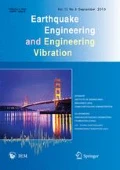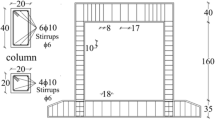Abstract
Damage to elevated water tanks in past earthquakes can be attributed to the poor performance of their supporting frame staging. In order to ascertain the performance of these elevated water tanks, it is crucial to categorize the damage in quantifiable damage states. Among various parameters to quantify the damage states, the top drift of frame staging can be conveniently correlated to the different damage levels. In literature, drift limits corresponding to different damage states of the frame staging of the elevated water tank are not available. In the present study, drift limits for RC frame staging in elevated water tanks corresponding to different seismic damage states have been proposed. Various damage states of the elevated water tank have been determined using the Park and Ang damage index. The Park and Ang damage index utilizes results of both pushover analysis and incremental dynamic analysis. Twelve models of elevated water tanks have been developed considering variation in staging height and tank capacity. Incremental dynamic analysis has been performed using the suite of twelve actual earthquake ground motions. Based on the regression analysis between damage indexes and drift, limiting drift values for each damage state are proposed.
Similar content being viewed by others
References
Adhikary S and Singh Y (2019), “Effect of Site Amplification on Inelastic Seismic Response,” Earthquake Engineering and Engineering Vibration, 18(3): 535–554. https://doi.org/10.1007/s11803-019-0520-y.
Aghagholizadeh M and Massumi A (2016), “A New Method to Assess Damage to RCMRFs from Period Elongation and Park-Ang Damage Index Using IDA,” International Journal of Advanced Structural Engineering, 8(3): 243–252.
ASCE 41-06 (2007), Seismic Rehabilitation of Existing Buildings, Virginia, USA: American Society of Civil Engineers.
ASCE 7 (2010), Minimum Design Loads for Buildings and Other Structures (ASCE-7), Virginia, USA: American Society of Civil Engineers.
Astaneh A and Ashtiany MG (1990), “The Manjil, Iran, Earthquake of June 1990,” Report No. 24(12), Earthquake Engineering Research Institute, California, USA.
Banon H and Veneziano D (1982), “Seismic Safety of Reinforced Concrete Members and Structures,” Earthquake Engineering & Structural Dynamics, 10(2): 179–193.
Banon H, Biggs JM and Irvine HM (1981), “Seismic Damage in Reinforced Concrete Frames,” Journal of Structural Engineering, ASCE, 107(9): 1713–1729.
Barbat AH, Pujades LG and Lantada N (2006), “Performance of Buildings under Earthquakes in Barcelona, Spain,” Computer-Aided Civil and Infrastructure Engineering, 21(3): 573–593.
Bassam A, Iranmanesh A and Ansari F (2011), “A Simple Quantitative Approach for Post Earthquake Damage Assessment of Flexure Dominant Reinforced Concrete Bridges,” Engineering Structures, 33(12): 3218–3225.
Bazzurro P and Cornell CA (1994), “Seismic Hazard Analysis of Nonlinear Structures. I: Methodology,” Journal of Structural Engineering, 120(11): 3320–3344.
Bracci JM, Reinhorn AM, Mander JB, et al. (1989), “Deterministic Model for Seismic Damage Evaluation of Reinforced Concrete Structures,” Technical Report NCEER 89-0033, State University of New York at Buffalo.
CED38(7811)P (2011), Criteria for Design of RCC Staging for Overhead Water Tanks, New Delhi, India: Bureau of Indian standards <http://bis.org.in/sf/ced/CED38(7811)P.pdf.>
Chung YS, Meyer C and Shinozuka M (1989), “Modeling of Concrete Damage,” ACI Structural Journal, 86(3): 259–271.
Colombo A and Negro P (2005), “A Damage Index of Generalised Applicability,” Engineering Structures, 27(8): 1164–1174.
DiPasquale E and Cakmak AS (1987), “Detection and Assessment of Seismic Structural Damage,” Technical Report NCEER 87-00 15, State University of New York at Buffalo.
DiPasquale E and Cakmak AS (1990), “Seismic Damage Assessment Using Linear Models,” Soil Dynamics & Earthquake Engineering, 9(4): 194–215.
DiPasquale E, Ju J-W, Askar A, et al. (1990), “Relation Between Global Damage Indices and Local Stiffness Degradation,” Journa1 of Structura1 Engineering, 16(5): 1440–1456.
Dumova-Jovanoska E (2000), “Fragility Curves for Reinforced Concrete Structures in Skopje (Macedonia) Region,” Soil Dynamics and Earthquake Engineering, 19(6): 455–466.
Dymiotis C, Kappos AJ and Chryssanthopoulos MK (1999), “Seismic Reliability of RC Frames with Uncertain Drift and Member Capacity,” Journal of Structural Engineering, 125(9): 1038–1047.
EN 1998-1:2004 (2004), Eurocode 8: Design of Structures for Earthquake Resistance. Part 1: General Rules, Seismic Actions and Rules for Buildings, Brussels, Belgium: European Committee for Standardization.
Erberik MA and Elnashai AS (2004), “Fragility Analysis of Flat-Slab Structures,” Engineering Structures, 26(7): 937–948.
Fardis M, Papailia A and Tsionis G (2012), “Seismic Fragility of RC Framed and Wall-Frame Buildings Designed to the EN-Eurocodes,” Bulletin of Earthquake Engineering, 10: 1767–1793.
FEMA P695 (2009), Quantification of Building Seismic Performance Factors, Washington, DC, USA: Federal Emergency Management Agency.
Ghosh S, Datta D and Katakdhond AA (2011), “Estimation of the Park-Ang Damage Index for Planar Multi-Storey Frames Using Equivalent Single-Degree Systems,” Engineering Structures, 33(9): 2509–2524.
Giovinazzi S (2005), “The Vulnerability Assessment and the Damage Scenario in Seismic Risk Analysis,” Ph.D. Thesis, Technical University Carolo-Wilhelmina at Braunschweig, Germany and University of Florence, Florence, Italy.
Gosain NK, Brown RH and Jersa JO (1977), “Shear Requirements for Load Reversals on RC Members,” Journal of the Structural Division, 103(7): 1461–1476.
Hwang TH (1982), “Effects of Variation in Load History on Cyclic Response of Concrete Flexural Members,” PhD Thesis, Dept. of Civil Engineering, University of Illinois, Illinois.
IS 13920 (2016), Ductile Detailing of Reinforced Concrete Structures Subjected to Seismic Forces- Code of Practice, New Delhi, India: Bureau of Indian Standard.
IS 1893 (Part 1) (2016), Criteria for Earthquake Resistant Design of Structures: Part 1 General Provisions and Buildings, New Delhi, India: Bureau of Indian Standard.
IS 1893 (Part 2) (2014), Criteria for Earthquake Resistant Design of Structures Part 2 Liquid Retaining Tanks, New Delhi, India: Bureau of Indian Standard.
IS 456 (2000), Plain and Reinforced Concrete-Code of Practice, New Delhi, India: Bureau of Indian Standards.
Jain SK, Murty CVR, Chandak N, et al. (1994), “The September 29, 1993, m6.4 Killari, Maharashtra Earthquake in Central India,” Report No. 28(1), Earthquake Engineering Research Institute, California, USA.
Jiang HJ, Chen LZ and Chen Q (2011), “Seismic Damage Assessment and Performance Levels of Reinforced Concrete Members,” Procedia engineering, 14: 939–945.
Kappos AJ (1997), “Seismic Damage Indices for RC Buildings: Evaluation of Concepts and Procedures,” Progress in Structural Engineering and Materials, 1(1): 78–87.
Kappos AJ, Panagopoulos G, Panagiotopoulos C and Penelis G (2006), “A Hybrid Method for the Vulnerability Assessment of R/C and URM Buildings,” Bulletin of Earthquake Engineering, 4(4): 391–413.
Kircil, MS and Polat Z (2006), “Fragility Analysis of Mid-Rise R/C Frame Buildings,” Engineering Structures, 28(9): 1335–1345.
Lakhade SO, Kumar R and Jaiswal OR (2017), “Estimation of Response Reduction Factor of RC Frame Staging in Elevated Water Tanks Using Nonlinear Static Procedure,” Structural Engineering and Mechanics, 62(2): 209–224.
Liu Jingbo, Tan Hui, Bao Xin, Wang Dongyang and Li Shutao (2019), “Seismic Wave Input Method for Three-Dimensional Soil-Structure Dynamic Interaction Analysis Based on the Substructure of Artificial Boundaries” Earthquake Engineering and Engineering Vibration, 18(4): 747–758. https://doi.org/10.1007/s11803-019-0534-5.
Lybas L and Sozen MA (1977), “Effect of Beam Strength & Stiffness on Dynamic Behavior of Reinforced Concrete Structures,” Report SRS, No. 444, University of Illinois, Urbana.
Mander JB Priestley MJ and Park R (1988), “Theoretical Stress-Strain Model for Confined Concrete,” Journal of Structural Engineering, 114(8): 1804–1826.
Mehanny S and Deierlein G (2001), “Seismic Damage and Collapse Assessment of Composite Moment Frames,” Journal of Structural Engineering, 127(9): 1045–1053.
Mehrain M (1990), “Reconnaissance Report on the Northern Iran Earthquake of June 21, 1990,” Research Report No. NCEER-90-0017, National Center for Earthquake Engineering Research, State University of New York at Buffalo, New York, USA.
Mizuhata K and Maeda Y (1989), “Study on Evaluation of Cumulative Damage Earthquake Response of Structures Based on Computer-Actuator on-Line Test,” Proceedings 9th World Conference on Earthquake Engineering, Vol. IV, Tokyo, Maruzen, pp. 83–88.
Mosalam KM, Ayala G, White RN and Roth C (1997), “Seismic Fragility of LRC Frames with and without Masonry Infill Walls,” Journal of Earthquake Engineering, 1(4): 693–719.
Newmark NM and Rosenblueth E (1971), Fundamentals of Earthquake Engineering, Prentice Hall, Englewood Cliffs, New Jersey.
Niu Ditao and Ren Lijie (1996), “A Modified Seismic Damage Model with Double Variables for Reinforced Concrete Structures,” Journal of Earthquake Engineering and Engineering Vibration, 16: 44–55.
Park R (1986), “Ductile Design Approach for Reinforced Concrete Frames,” Earthquake Spectra, 2(3): 565–619.
Park Y and Ang A (1985), “Mechanistic Seismic Damage Model for Reinforced Concrete,” Journal of Structural Engineering, 111(4): 722–739.
PEER (2006), PEER NGA Database, Pacific Earthquake Engineering Research Center, University of California <http://peer.berkeley.edu/nga/.>
Pejovic J and Jankovic S (2016), “Seismic Fragility Assessment for Reinforced Concrete High-Rise Buildings in Southern Euro-Mediterranean Zone,” Bulletin of Earthquake Engineering, 14(1): 185–212.
Polese M, Verderame GM, Mariniello C, Iervolino I and Manfredi G (2008), “Vulnerability Analysis for Gravity Load Designed RC Buildings in Naples - Italy,” Journal of Earthquake Engineering, 12(S2): 234–245.
Powell GH and Allahabadi R (1988), “Seismic Damage Prediction by Deterministic Methods: Concept and procedure,” Earthquake Engineering and Structural Dynamics, 16(5): 719–734.
Rai DC (2002), “Elevated tanks,” Earthquake Spectra, 18(S1): 279–295.
Rai DC (2003), “Performance of Elevated Tanks in mw 7.7 Bhuj Earthquake of January 26th, 2001,” Journal of Earth System Science, 112(3): 421–429.
Rajabi R, Barghi M, and Rajabi R (2012), “Investigation of Park-Ang Damage Index Model for Flexural Behavior of Reinforced Concrete Columns,” The Structural Design of Tall and Special Buildings, 22(17): 1350–1358.
Roufaiel MS and Meyer C (1987), “Analytical Modeling of Hysteretic Behavior of R/C Frames,” Journal of Structural Engineering, 113(3): 429–444.
Saffarini HS (2000), “Ground Motion Characteristics of the November 1995 Aqaba Earthquake,” Eng. Struct., 22(4): 343–351.
SAP2000 (2004), Integrated Software for Structural Analysis & Design, Computers and Structures Inc., Berkeley, California.
Shome N (1999), “Probabilistic Seismic Demand Analysis of Nonlinear Structures,” PhD Thesis, Stanford University, California, USA.
Singhal A and Kiremidjian AS (1995), “Method for Developing Motion Damage Relationships for Reinforced Concrete Frames,” Technical Report NCEER 95-0008, State University of New York at Buffalo.
Sinha R and Shiradhonkar SR (2012), “Seismic Damage Index for Classification of Structural Damage - Closing the Loop,” 15th World Conference on Earthquake Engineering, Lisboa.
Steinbrugge KV and Flores R (1963), “The Chilean Earthquakes of May, 1960: a Structural Engineering Viewpoint,” Bulletin of the Seismological Society of America, 53(2): 225–307.
Stephens JE and Yao JT (1987), “Damage Assessment Using Response Measurements,” Journal of Structural Engineering, 113(4): 787–801.
Vamvatsikos D and Cornell CA (2002), “Incremental Dynamic Analysis,” Earthquake Engineering & Structural Dynamics, 31(3): 491–514.
Wang ML and Shah SP (1987), “Reinforced Concrete Hysteresis Model Based on the Damage Concept,” Earthquake Engineering & Structural Dynamics, 15(8): 993–1003.
Yazdannejad K and Yazdani A (2018), “Bayesian Updating of the Park-Ang Damage Index for RC Frame Buildings under Near-Fault Ground Motions,” Scientia Iranica, 25(2): 606–616.
Yüksel E and Sürmeli M (2010), “Failure Analysis of One-Story Precast Structures for Near-Fault and Far- Fault Strong Ground Motions,” Bulletin of Earthquake Engineering, 8(4): 937–953.
Zameeruddin M and Sangle KK (2016), “Review on Recent Developments in the Performance-Based Seismic Design of Reinforced Concrete Structures,” Structures, 6: 119–133.
Author information
Authors and Affiliations
Corresponding author
Rights and permissions
About this article
Cite this article
Lakhade, S.O., Kumar, R. & Jaiswal, O.R. Estimation of drift limits for different seismic damage states of RC frame staging in elevated water tanks using Park and Ang damage index. Earthq. Eng. Eng. Vib. 19, 161–177 (2020). https://doi.org/10.1007/s11803-020-0554-1
Received:
Accepted:
Published:
Issue Date:
DOI: https://doi.org/10.1007/s11803-020-0554-1




